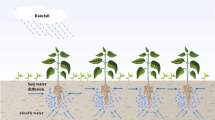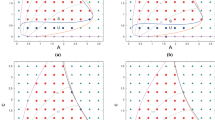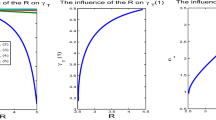Abstract
Self-organized vegetation patterns in space were found in arid and semi-arid areas. In this paper, we modelled a vegetation model in an arid flat environment using reaction-diffusion form and investigated the pattern formation. By using Hopf and Turing bifurcation theory, we obtain Turing region in parameters space. It is found that there are different types of stationary patterns including spotted, mixed, and stripe patterns by amplitude equation. Moreover, we discuss the changes of the wavelength with respect to biological parameters. Specifically, the wavelength becomes smaller as rainfall increases and larger as plant morality increases. The results may well explain the vegetation pattern observed in the real world and provide some new insights on preventing from desertification.










Similar content being viewed by others
References
Klausmeier, C.A.: Regular and irregular patterns in semiarid vegetation. Science 284, 1826–1828 (1999)
Rietkerk, M., van de Koppel, J.: Regular pattern formation in real ecosystems. Trends Ecol. Evol. 23, 169–175 (2007)
Couteron, P., Lejeune, O.: Periodic spotted patterns in semiarid vegetation explained by a propagation-inhibition model. J. Ecol. 89, 616–628 (2001)
HilleRisLambers, R., Rietkerk, M., van den Bosch, F., Prins, H.H.T., de Kroon, H.: Vegetation pattern formation in semiarid grazing systems. Ecology 82, 50–61 (2001)
von Hardenberg, J., Meron, E., Shachak, M., Zarmi, Y.: Diversity of vegetation patterns and desertification. Phys. Rev. Lett. 87, 198101 (2001)
Shnerb, N.M., Sara, P., Lavee, H., Solomon, S.: Reactive glass and vegetation patterns. Phys. Rev. Lett. 90, 038101 (2003)
Barbier, N., Couteron, P., Lejoly, J., Deblauwe, V., Lejeune, O.: Self-organized vegetation patterning as a fingerprint of climate and human impact on semi-arid ecosystems. J. Ecol. 94, 537–547 (2006)
Ursino, N., Rulli, M.C.: Combined effect of fire and water scarcity on vegetation patterns in arid lands. Ecol. Model. 221, 2353–2362 (2010)
Kefi, S., Rietkerk, M., Alados, C.L., Pueyo, Y., Papanastasis, V.P., ElAich, A., de Ruiter, P.C.: Spatial vegetation patterns and imminent desertification in Mediterranean arid ecosystems. Nature 449, 213–217 (2007)
Scheffer, M., Bascompte, J., Brock, W.A., Brovkin, V., Carpenter, S.R., Dakos, V., Held, H., van Nes, E.H., Rietkerk, M., Sugihara, G.: Early-warning signals for critical transitions. Nature 461, 53–59 (2009)
Lade, S.J., Gross, T.: Early warning signals for critical transitions: a generalized modeling approach. PLoS Comput. Biol. 8, e1002360 (2012)
Marinov, K., Wang, T., Yang, Y.: On a vegetation pattern formation model governed by a nonlinear parabolic system. Nonlinear Anal., Real World Appl. 14, 507–525 (2013)
Ursino, N.: Above and below ground biomass patterns in arid lands. Ecol. Model. 220, 1411–1418 (2009)
Kefi, S., Eppinga, M.B., de Ruiter, P.C., Rietkerk, M.: Bistability and regular spatial patterns in arid ecosystems. Theor. Ecol. 3, 257–269 (2010)
Sheffer, E., von Hardenberg, J., Yizhaq, H., Shachak, M., Meron, E.: Emerged or imposed: a theory on the role of physical templates and self-organisation for vegetation patchiness. Ecol. Lett. 16, 127–139 (2012)
Sherratt, J.A.: History-dependent patterns of whole ecosystems. Ecol. Complex. 14, 8–20 (2013)
Borgogno, F., D’Odorico, P., Laio, F., Ridolfi, L.: Mathematical models of vegetation pattern formation in ecohydrology. Rev. Geophys. 47, RG1005 (2009)
Ouyang, Q.: Pattern Formation in Reaction-Diffusion Systems. Shanghai Sci-Tech Education Publishing House, Shanghai (2000)
Peña, B., Pérez-García, C.: Stability of turing patterns in the Brusselator model. Phys. Rev. E 64, 056213 (2001)
Rietkerk, M., Boerlijst, M.C., van Langevelde, F., HilleRisLambers, R., van de Koppel, J., Kumar, L., Prins, H.H.T., de Roos, A.M.: Self-organization of vegetation in arid ecosystems. Am. Nat. 160, 524–530 (2002)
Rietkerk, M., Decker, S.C., de Ruiter, P.C., van de Koppel, J.: Self-organized patchiness and catastrophic shift in ecosystems. Science 305, 1926–1929 (2004)
Kealy, B.J., Wollkind, D.J.: A nonlinear stability analysis of vegetative Turing pattern formation for an interaction-diffusion plant-surfacewater model system in an arid flat environment. Bull. Math. Biol. 74, 803–833 (2012)
Sherratt, J.A.: An analysis of vegetative stripe formation in semi-arid landscape. J. Math. Biol. 51, 183–197 (2005)
Sherratt, J.A., Lord, G.J.: Nonlinear dynamics and pattern bifurcations in a model for vegetation stripes in semi-arid environments. Theor. Popul. Biol. 71, 1–11 (2007)
Dufiet, V., Boissonade, J.: Dynamics of Turing pattern monolayers close to onset. Phys. Rev. E 53, 4883–4892 (1996)
Wang, B., Wang, A.-L., Liu, Y.-J., Liu, Z.-H.: Analysis of a spatial predator-prey model with delay. Nonlinear Dyn. 62, 601–608 (2010)
Herrmann, H.-J.: Pattern formation of dunes. Nonlinear Dyn. 44, 315–317 (2006)
Sun, G.-Q., Zhang, G., Jin, Z.: Predator cannibalism can give rise to regular spatial pattern in a predator-prey system. Nonlinear Dyn. 58, 75–84 (2009)
Sun, G.-Q., Jin, Z., Li, L., Li, B.-L.: Self-organized wave pattern in a predator-prey model. Nonlinear Dyn. 60, 265–275 (2010)
Pinto, C.M.A., Machado, J.T.A.: Fractional central pattern generators for bipedal locomotion. Nonlinear Dyn. 62, 27–37 (2010)
Fasani, S., Rinaldi, S.: Remarks on cannibalism and pattern formation in spatially extended prey-predator systems. Nonlinear Dyn. 62, 2543–2548 (2012)
Cross, M.C., Hohenberg, P.C.: Pattern formation outside of equilibrium. Rev. Mod. Phys. 65, 851–1112 (1993)
Sun, G.-Q., Jin, Z., Tan, Q.: Measurement of self-organization in arid ecosystems. J. Biol. Syst. 18, 495–508 (2010)
Gunaratne, G., Ouyang, Q., Swinney, H.: Pattern formation in the presence of symmetries. Phys. Rev. E 50, 2802 (1994)
Manneville, P.: Dissipative Structures and Weak Turbulence. Academic Press, San Diego (2000)
Zhang, X.-C., Sun, G.-Q., Jin, Z.: Spatial dynamics in a predator-prey model with Beddington-DeAngelis functional response. Phys. Rev. E 85, 021924 (2012)
Scheffer, M., Carpenter, S., Foley, J.A., Folke, C., Walker, B.: Catastrophic shifts in ecosystems. Nature 413, 591–596 (2001)
Meron, E., Yizhaq, H., Gilad, E.: Localized structures in dryland vegetation: forms and functions. Chaos 17, 037109 (2007)
Acknowledgements
The research was partially supported by the National Natural Science Foundation of China under Grant No. 11147015, Natural Science Foundation of Shan’Xi Province Grant Nos. 2012021002-1 and 2012011002-2, the opening foundation of the Institute of Information Economy, Hangzhou Normal University, Grant No. PD12001003002003, International and Technical Cooperation Project of Shanxi Province (2010081005) and Graduate Students’ Excellent Innovative Item of Shanxi Province No. 20113107.
Author information
Authors and Affiliations
Corresponding author
Rights and permissions
About this article
Cite this article
Sun, GQ., Li, L. & Zhang, ZK. Spatial dynamics of a vegetation model in an arid flat environment. Nonlinear Dyn 73, 2207–2219 (2013). https://doi.org/10.1007/s11071-013-0935-3
Received:
Accepted:
Published:
Issue Date:
DOI: https://doi.org/10.1007/s11071-013-0935-3




